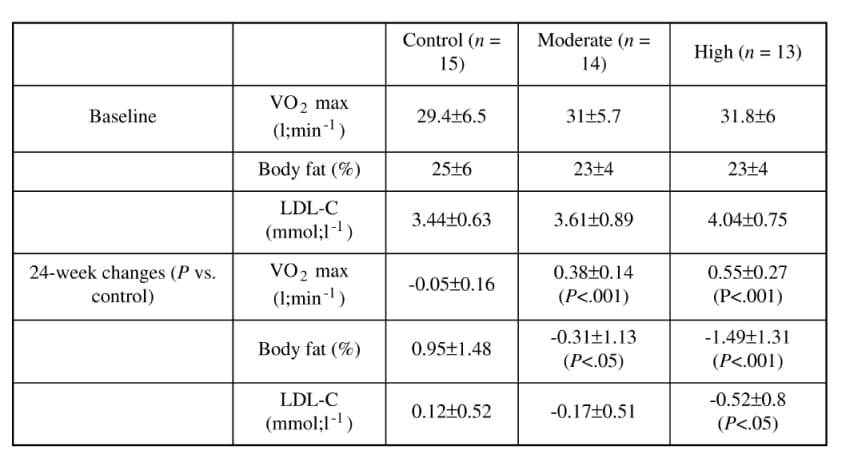Low-density lipoprotein cholesterol (LDL-C) is the primary target of cholesterol lowering therapy and exercise training is regarded as a therapeutic intervention (NCEP, 2002). However, there is insufficient evidence to characterise the dose-response relationship. In particular, it is unclear whether moderate- or high-intensity exercise confers greater reductions in LDL-C. Thus, the present study was undertaken to investigate the effects of exercise intensity on LDL-C.Sixty-six inactive, non-smoking men aged 30-45 years volunteered to take part in this study and agreed not to change their dietary habits during the intervention. Fasting measures of total cholesterol, triglycerides and high-density lipoprotein cholesterol were obtained in order to estimate LDL-C (Friedewald et al., 1972). Physical fitness (maximum oxygen consumption, VO2 max) and body fat (estimated from skinfolds) were measured in 62 normolipidaemic men before random allocation to a control group (n = 19), a moderate-intensity exercise group (three 400 kcal sessions per week at 60% of VO2 max, n = 22) or a high-intensity exercise group (three 400 kcal sessions per week at 80% of VO2 max, n = 21). Baseline measurements and 24-week changes were compared using a one-way ANOVA and, where appropriate, a Bonferroni post hoc test. This study was approved by the Local Research Ethics Committee. Results are reported for men who finished the study (Table). There were no inter-group differences in physical fitness, body fat or LDL-C at baseline. Twenty-four-week changes in physical fitness and body fat were significantly different in the exercise groups compared to the control group. Significant changes in LDL-C were only observed in the high-intensity exercise group compared to the control group. The exercise-induced reduction in LDL-C was greater than that attributable to biological variation (Ricos et al., 1999) and was not correlated with the change in body fat (r = -0.07). These results suggest that high-intensity exercise is required to reduce LDL-C.
University of Glasgow (2004) J Physiol 557P, C73
Communications: The effects of 24 weeks of moderate- or high-intensity exercise on low-density lipoprotein cholesterol: a randomised controlled trial
G. O’Donovan (a),A. Nevill (b) and E. Kearney(c)
(a) Department of Sport Science, Canterbury Christ Church University College, Canterbury, UK, (b) School of Sport, Performing Arts and Leisure, University of Wolverhampton, Wolverhampton, UK and (c) Department of Clinical Biochemistry, QEQM Hospital, Margate, UK
View other abstracts by:
Where applicable, experiments conform with Society ethical requirements.

